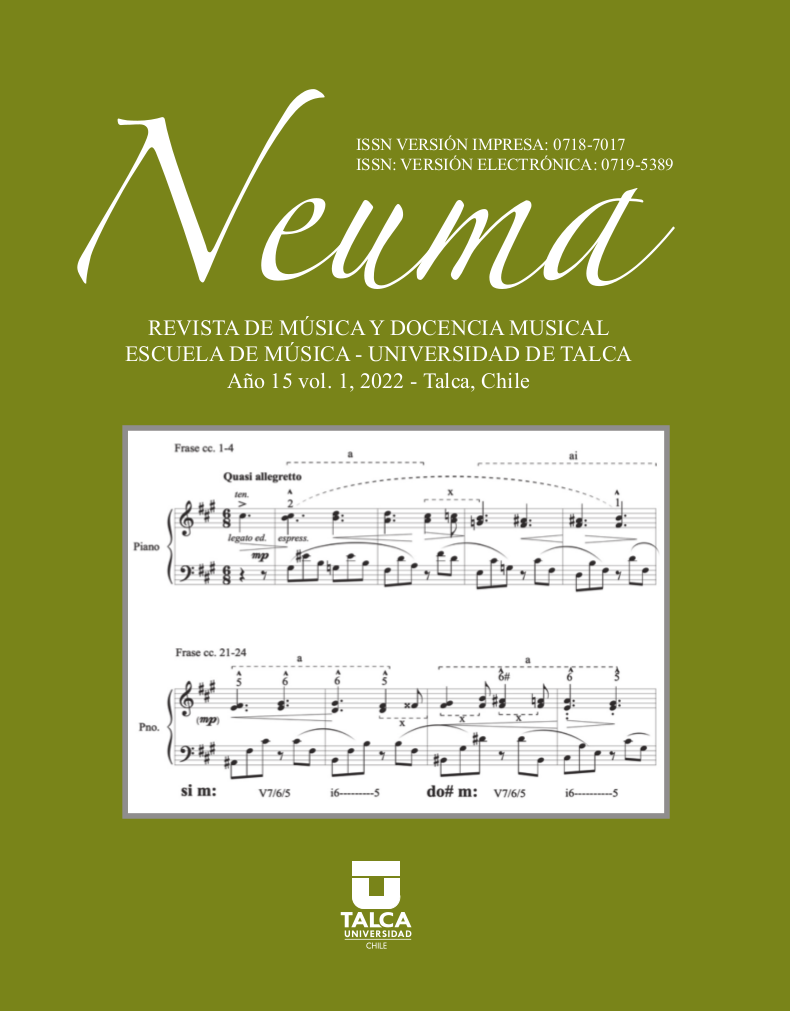Abstract
In the last decades, authors such as Hatten, Tarasti and Grabócz have developed musical discourse analysis under the narrative aspect, revealing new possibilities to understand the latent meanings in instrumental works. The musician and psychiatrist Claudio Naranjo (1932 – 2019) affirms that the sonata form is an organic form that allows the expression of mythical experiences and that its different ways of structuring bear significant similarities with the archetypal narratives known by scholars of myths as “The hero’s journey.” Developing this theme, we will present the narrative analysis of the 1st movement of Schumann’s Quintet for piano and strings in Eb major op.44, based on a poem that corresponds note by note to the melodic lines of this work. Its author, Tótila Albert Schneider (1892-1967), a famous Chilean sculptor and poet, created an original poetic-musical work that he called “Musical Dictations”, original poems in German that must be read in sync with the musical discourse, like a song. The content of these poems is articulated with the formal and harmonic processes revealing surprising possibilities for the narrative analysis of the corresponding works. Through thematic analysis and harmonic regions, a comparison will be made between the sections of the 1st movement of this work and the corresponding parts of the poem synchronized with its melodic lines. The narrative logic of the poem is intimately related to the formal processes that constitute this work built in the sonata form and opens up new possibilities for the field of study of musical narratology.
References
Agawu, Kofi (2012). La Música como discurso: Aventuras semióticas en la música romántica. Buenos Aires: Eterna.
Albert,Tótila (sd). Das Annerkannte Du. Epos VI (Manuscrito).
Albert, Tótila (2015). Die Geburt aus dem Ich Teil 1 – 5 – Epos. Verlag: Books on Demand.
Bekker, Paul (1912). Beethoven. Berlín: Schuster & Loeffler.
Bekker, Paul (sf). En: https://schenkerdocumentsonline.org/mobile/profiles/person/entity-000057:.pdf. Consultado el 20 de febrero de 2022.
Brendel, Franz (1845) “Robert Schumann with Reference to MendelssohnBartholdy and the Development of Modern Music in General (1845),” in Schumann and His World, ed. R. Larry Todd, trans. Jürgen Thym (Princeton: Princeton University Press, 1994), pp. 331.
Campbell, Joseph (1959). El Héroe de las mil caras (1ª ed. 1949). México: Fondo de Cultura Económica.
Caplin, William E. (1998). Classical Form: A Theory of Formal Functions for the Music of Haydn, Mozart, and Beethoven. Oxford: Oxford University Press.
Casablancas, Benet (2020). Paisajes del Romanticismo musical. Soledad y desarraigo, noche y ensueño, quietud y éxtasis. Del estancamiento
clásico a la plenitud romántica. Barcelona: Galaxia Gutenberg.
Gertsch, Emily (2013). Narratives of Innocence and Experience: Plot Archetypes in Robert Schumann’s Piano Quintet and Piano Quartet. Doctoral Thesis. The Florida State University College of Music.
Grabócz, Márta (2009). “Fórmulas recurrentes de la narrativa en los géneros extra-musicales y en la música”, Revista (Pensamiento), (Palabra) y Obra, 1, pp. 57-66.
Grabócz, Márta (2020). “From Music Signification to Musical Narrativity: Concepts and analyses’. The Routledge Handbook of Music Signification. New York: Routledge Music Handbooks, pp. 197-206.
Gómez, Arturo García (2008). Teoría de la entonación. Sobre el proceso de formación de la música en la vida y obra de Boris V. Asafiev (1884-1949). Tesis Doctoral, Madrid: UAM.
Hanslick, Edward (2002). Do Belo Musical (1853). Lisboa: Edições 70.
Hatten, Robert (1991). “On Narrativity in Music: Expressive Genres and Levels of Discourse in Beethoven”. Indiana Theory Review. Indiana: Indiana University Press, pp. 75-98.
Hatten, Robert (2004). Interpreting Musical Gestures, Topics and Tropes: Mozart, Beethoven, Schubert. Bloomington: Indiana University Press.
Hepokoski, James y Warren Darcy (2006). Elements of Sonata Theory: Norms, Types, and Deformations in the Late-Eighteenth Century Sonata. New York and Oxford: Oxford University Press.
Horton, Julian (2017). “Criteria for a theory of nineteenth-century sonata form”, Music theory and analysis (MTA), 4, 2. pp. 147-191.
Jung, Carl Gustav (2000). Os arquétipos e o inconsciente coletivo. Petrópolis: RJ. Vozes.
Kozel, David (2016). “Mythological Archetype in Music and Principles of its Interpretation”, International Review of the Aesthetics and Sociology of Music, 47, 1, pp. 3-15.
Kretzschmar, Hermann (Herausgegeben) (1920). Kleine Handbücher Der Musikgeschichte nach Gattungen, Band VII. Leipzig: Druck und Verlag von Breitkopf & Härtel.
López-Cano, Rubén (2020). La música cuenta: Retórica, narratividad, dramaturgia, cuerpo y afectos. Barcelona: ESMUC.
Marx, Adolph Bernhard (1997). “Form in Music.” In Musical Form in the Age of Beethoven: Selected Writings on Theory and Method. Edited and translated by Scott Burnham. Cambridge: Cambridge University Press, pp. 55-90.
Meyer, Leonard (2005). La emoción y el significado en la música (1956). Madrid: Alianza Editorial.
Moortele, Steven Vande (2013). “In Search of Romantic Form”, Music Analysis, 32, 3, pp. 404–431.
Naranjo, Claudio (1949). Movimiento Perpetuo para piano. Valparaíso: Ricordi.
Naranjo, Claudio (1998). El diálogo y la obra de Tótila Albert. Música, Arte y Proceso, 6, pp. 49-74.
Naranjo, Claudio (2015). La Música Interior. Barcelona: Ed. La Llave.
Naranjo, Claudio (2018). Ascenso y Descenso de la Montaña Sagrada. Santiago de Chile: Penguin Random House, pp. 1-804.
Naranjo, Claudio (2021). “Dictado Musical. Volumen I. Quinteto para piano y cuerdas Op.44 de Robert Schumann”. Edición digital. En:
https://www.claudionaranjo.net/content_phoenix_spanish/totila_albert_spanish.html . Consultado el 15 de febrero de 2022.
Nietzsche, Friedrich (2011). Assim Falou Zaratustra (1883). São Paulo: Companhia das Letras.
Propp, Vladimir (2009). Morphology of the Folk Tale, Austin: University of Texas Press.
Ratner, Leonard (1980). Classic Music: Expression, Form and Stile. New York: Schirmer Books.
Rocha Baía y Pedro Rodrigues (2017). A Perda da Dedicatória à Eroica. Análise de como a obra de Beethoven foi influenciada por Napoleão. Trabalho de Conclusão de Curso – Centro de Ciências Humanas (CCH). Universidade Estadual de Londrina.
Rosen, Charles (1980). Formas de Sonata. Barcelona: Editorial Labor.
Schering, Arnold (2001). “The Eroica: Beethoven’s Homer Symphony? (1934)”. Current Musicology, 69, (Spring 2000), pp. 68-96.
Schmalfeldt, Janet (2011). ln the Process of Becoming: Analytic and Philosophical Perspectives on Form in Early Nineteenth-Century Music. New York: Oxford University Press.
Schumann, Robert (s.d.). Quintett für piano, zwei violinen, viola und violoncel op.44. Leipzig: Breitkopf & Hartel.

This work is licensed under a Creative Commons Attribution-NonCommercial 4.0 International License.
Copyright (c) 2022 Neuma (Talca)


